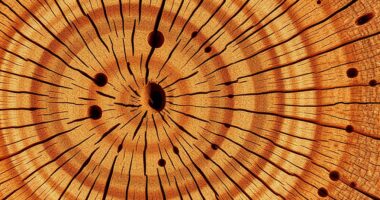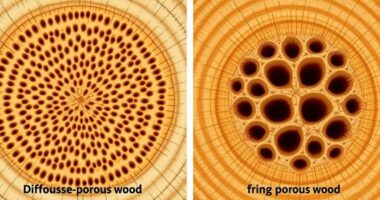To tell pine from cedar, look at the grain – pine has straight, uniform, smooth grain, while cedar’s is more textured and irregular. Notice the color too: pine is lighter, from pale yellow to light brown, whereas cedar displays richer reddish-brown tones. Check the knots—pine often has larger, more prominent knots, while cedar’s knots are smaller and less frequent. Paying attention to these details will help you distinguish between them more easily as you continue exploring.
Key Takeaways
- Pine has straight, uniform grain with a smooth texture, while cedar exhibits wavy or irregular, textured grain patterns.
- Pine’s color ranges from pale yellow to light brown, whereas cedar features warmer, reddish-brown tones that deepen with age.
- Knots in pine are often large and prominent, while cedar’s knots are smaller, less frequent, and may be darker or contrasting.
- Pine’s grain appears consistent and smooth, contrasting with cedar’s more varied and textured appearance.
- Combining grain pattern, color, and knot size offers the most reliable way to distinguish between the two woods.

Have you ever wondered how to tell pine and cedar apart? It’s a common question for anyone trying to identify these popular woods, whether for furniture making, interior design, or simple curiosity. The key lies in observing their grain patterns and color differences, which can help you distinguish one from the other quickly and confidently.
When examining the grain patterns, you’ll notice that pine typically has a relatively straight, uniform grain with a fine, even texture. The lines tend to be consistent, showing a somewhat smooth appearance that makes it easy to identify. Cedar, on the other hand, often displays more varied and sometimes more pronounced grain patterns. Its grain can appear wavy or irregular, giving it a more textured look. Cedar’s grain tends to be more open and can sometimes reveal growth rings more clearly, especially in older, softer boards. These differences in grain patterns are noticeable once you look closely, and they serve as reliable indicators for identification.
Pine has straight, uniform grain; cedar’s grain is wavy, irregular, and more textured.
Color differences are another straightforward way to distinguish pine from cedar. Pine generally has a lighter hue, often ranging from pale yellow to light brown. Its color can vary slightly depending on the species and whether it’s been stained or finished, but overall, pine maintains a lighter, more uniform tone. Cedar, in contrast, has a richer, warmer color palette. It ranges from reddish-brown to deep, fragrant reddish hues, which tend to deepen with age. The vibrant, warm tones of cedar stand out against the more subdued, pale shades of pine. If you’re comparing pieces side-by-side, these color differences are often the easiest initial clues to identify.
In addition to the grain and color, you might notice the presence of knots. Pine typically has more prominent knots, which are often large and noticeable, adding a rustic charm but sometimes reducing its structural integrity. Cedar can also have knots, but they tend to be smaller and less frequent. The knots in cedar can sometimes have a darker or contrasting color, making them stand out even more.
Frequently Asked Questions
Can Pine and Cedar Be Used Interchangeably in Furniture?
You can’t really use pine and cedar interchangeably in furniture because their wood density and scent differences matter. Pine tends to be softer and more prone to dents, while cedar is denser and more durable. Cedar also has a distinctive aroma that repels insects, unlike pine. These qualities influence how each wood ages and smells over time, making them better suited for specific furniture projects rather than interchangeable options.
How Do Pests Affect Pine and Cedar Differently?
Pests affect pine and cedar differently because cedar has better pest resistance, making it less attractive to insects like termites and beetles. With pine, you’re more likely to see infestation signs such as holes, frass, or damaged wood, indicating pests are active. Cedar’s natural oils help repel pests, so you won’t need to worry as much about pest issues, but regular inspections are still important to catch any early signs of infestation.
Are There Environmental Benefits to Choosing Pine Over Cedar?
Choosing pine over cedar offers sustainability advantages, as pine forests grow quickly and can be harvested sustainably with eco friendly harvesting practices. This means your choice supports responsible forestry, reducing environmental impact. Pine’s rapid growth allows for more frequent harvesting, helping to preserve ecosystems and reduce deforestation. By selecting pine, you contribute to a more eco-conscious approach to building and furniture-making, promoting a healthier planet for future generations.
What Are the Cost Differences Between Pine and Cedar?
When it comes to pricing comparison, pine generally costs less than cedar, making it a budget-friendly choice for many projects. You’ll find material costs for pine tend to be lower due to its abundance and faster growth rate. Cedar, being more durable and sought after for its aroma and appearance, commands higher prices. So, if you’re watching your budget, pine might be the way to go, but cedar offers longevity for a slightly higher price.
How Does Weathering Impact Pine Versus Cedar Over Time?
Weathering effects impact pine and cedar differently over time. You’ll notice pine’s surface aging more quickly, with its softer wood showing signs like graying and surface roughness sooner. Cedar, with its natural oils, resists weathering effects better, maintaining its appearance longer. As it weathers, cedar’s color remains more stable, while pine’s surface may develop cracks and a duller look, requiring more frequent maintenance to preserve its look.
Conclusion
Now that you know the key differences in grain, color, and knots, distinguishing pine from cedar becomes easier. Did you know that cedar trees can live up to 1,000 years, often developing more prominent knots over time? With this knowledge, you can confidently identify these woods in your projects. Remember, paying attention to grain and color details will help you make the right choice every time. So, trust your eye—your woodworking skills are about to improve!









